
Bergeijk municipality /
Gemeente Bergeijk (NB)
Municipality in the south-east of the Campine region, covering the villages Bergeijk, Loo, Weebosch, Riethoven, Westerhoven and Luyksgestel. The latter village belonged to the Luik/Liege Prince-Bishopric and remained catholic after the Reformation.
Gemeente in het zuidoosten van de Kempen, bestaand uit de dorpen Bergeijk, Loo, Weebosch, Riethoven, Westerhoven en Luyksgestel. Dit laatste dorp behoorde tot het prinsbisdom Luik en bleef na de Reformatie katholiek.
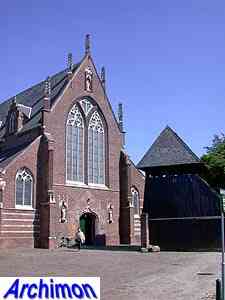 The
St. Petrus' Banden
or Hofkerk is a Gothic
church from the 15th
and 16th century. After the tower collapsed in 1650, a bell-house was
built to replace it. It's the only surviving bell-house in this
province. The church itself was lenghtened during a restoration by architect C. Franssen in 1888-1893.
The
St. Petrus' Banden
or Hofkerk is a Gothic
church from the 15th
and 16th century. After the tower collapsed in 1650, a bell-house was
built to replace it. It's the only surviving bell-house in this
province. The church itself was lenghtened during a restoration by architect C. Franssen in 1888-1893.Location: Hof 12
De St. Petrus' Banden of Hofkerk is een gotische kerk uit de 15e en 16e eeuw. Nadat in 1650 de toren instortte werd ter vervanging een luihuis gebouwd. Het is de enige overlevende belhuis in deze provincie. De kerk zelf werd tijdens een restauratie door architet C. Franssen in 1888-1893 verlengd.
Locatie: Hof 12
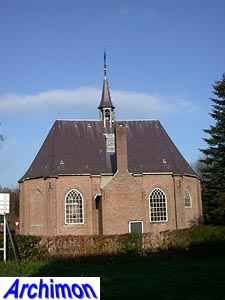 From
1648 until 1798 the protestants had used the Hofkerk. In that latter
year the church was returned to the catholics. In 1812 a new
protestant church
was built by order of king Lodewijk Napoleon, a small
building in neo-Classical
style.
From
1648 until 1798 the protestants had used the Hofkerk. In that latter
year the church was returned to the catholics. In 1812 a new
protestant church
was built by order of king Lodewijk Napoleon, a small
building in neo-Classical
style.Location: Domineestraat 10
Van 1648 tot 1798 hadden de protestanten gebruik gemaakt van de Hofkerk. In dat laatste jaar werd de kerk teruggegeven aan de katholieken. In 1812 werd een nieuwe protestantse kerk gebouwd in opdracht van koning Lodewijk Napoleon, een klein gebouw in neoclassicistische stijl.
Locatie: Domineestraat 10
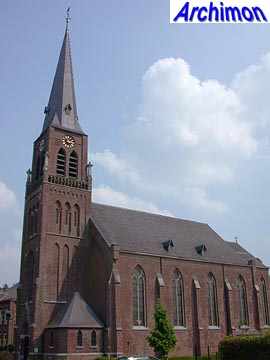 The
St. Petrus is a
neo-Gothic hall-church designed by C. Weber
and built in 1862-1863. The tower was designed by
C. Franssen and added in 1896.
The
St. Petrus is a
neo-Gothic hall-church designed by C. Weber
and built in 1862-1863. The tower was designed by
C. Franssen and added in 1896.Location: Loo 81
De St. Petrus is een neogotische hallenkerk ontworpen door C. Weber en gebouwd in 1862-1863. De toren is ontworpen door C. Franssen en werd toegevoegd in 1896.
Locatie: Loo 81
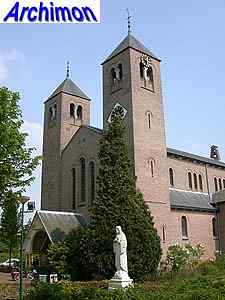 The
St. Gerardus Majella was built in 1907 and was designed by J. Stuyt
in
a neo-Romanesque style as often used by this architect for village churches.
The
St. Gerardus Majella was built in 1907 and was designed by J. Stuyt
in
a neo-Romanesque style as often used by this architect for village churches.
Location: Weebosch 75
De St. Gerardus Majella werd gebouwd in 1907 en is ontworpen door J. Stuyt in een neoromaanse stijl zoals deze architect die vaak toepaste voor dorpskerken.
Locatie: Weebosch 75
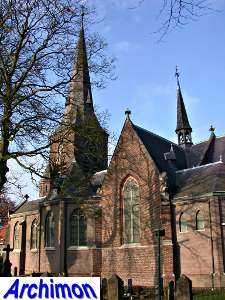 The
St. Willibrordus dates back to the 15th century. However, after architect C.
Franssen enlarged it in 1890-1899, of the original Gothic
church only
parts of the tower, the transept and the choir remain.
The
St. Willibrordus dates back to the 15th century. However, after architect C.
Franssen enlarged it in 1890-1899, of the original Gothic
church only
parts of the tower, the transept and the choir remain. Location: Dorpsplein
De St. Willibrordus dateert uit de 15e eeuw. Echter, nadat architect C. Franssen de kerk in 1890-1899 uitbreidde resteert van de oorspronkelijke gotische kerk slechts delen van de toren, het transept en het koor.
Locatie: Dorpsplein 6
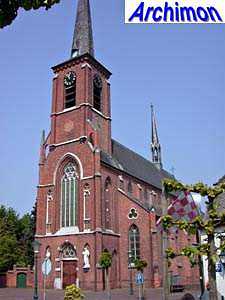 The
St. Servatius
is a three-aisled church in neo-Gothic
style, designed by
H.J. van Tulder and built in 1885-1886.
The
St. Servatius
is a three-aisled church in neo-Gothic
style, designed by
H.J. van Tulder and built in 1885-1886.Location: Dorpsstraat 22
De St. Servatius is een driebeukige kerk in neogotische stijl, ontworpen door H.J. van Tulder en gebouwd in 1885-1886.
Locatie: Dorpsstraat 22
 The
St. Martinus
is a modern church, designed by E. Nijsten and built in 1958 next to a
neo-Gothic church which was subsequently demolished, leaving only the 15th
century Gothic tower.
The
St. Martinus
is a modern church, designed by E. Nijsten and built in 1958 next to a
neo-Gothic church which was subsequently demolished, leaving only the 15th
century Gothic tower.Location: Kerkstraat 100
De St. Martinus is een moderne kerk, ontworpen door E. Nijsten en gebouwd in 1958 naast een neogotische kerk, die vervolgens werd afgebroken. Alleen de gotische toren uit de 15e eeuw bleef over.
Locatie: Kerkstraat 100
 The
Kruiskapel ('chapel of the cross') is a small pilgrimage chapel in a traditional
style, built in 1727 and extended with a portal in 1842.
The
Kruiskapel ('chapel of the cross') is a small pilgrimage chapel in a traditional
style, built in 1727 and extended with a portal in 1842. Location: Kapellerweg 26
De Kruiskapel is een kleine bedevaartskapel in traditionele stijl, gebouwd in 1727 en uitgebreid met een portaal in 1842.
Locatie: Kapellerweg 26